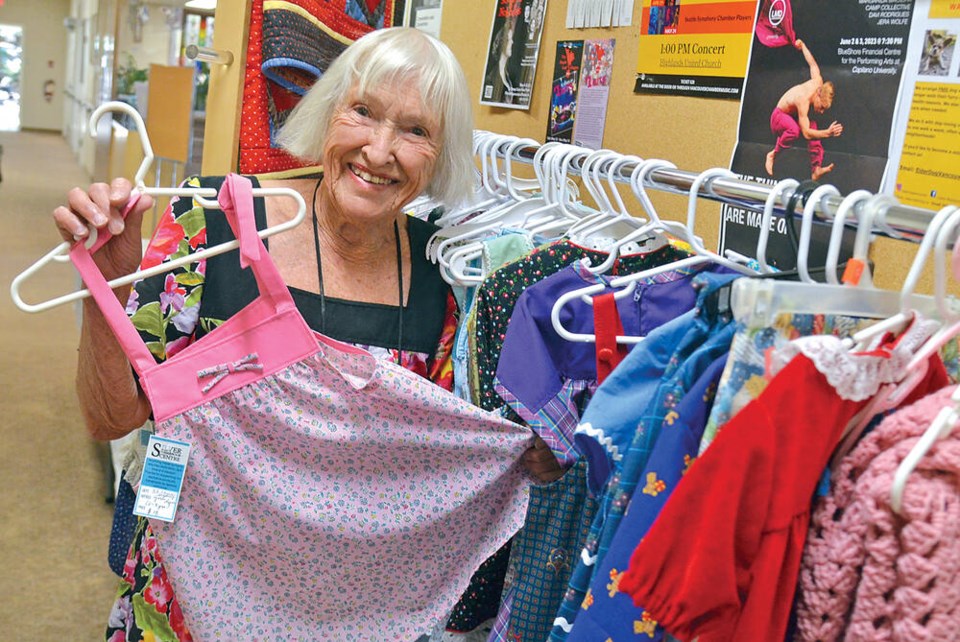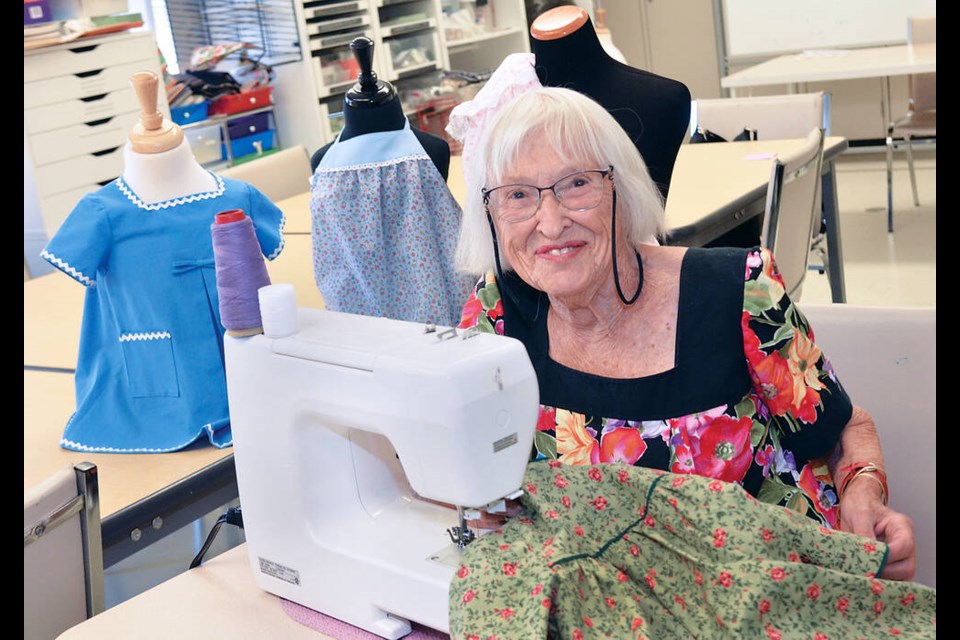When Gerda Swift was just 14, she made her first show-stopping outfit.
It was the end of the Second World War in Germany and there was no material to be bought. She went to her grandfather, who had been a tailor, and asked if he could help. He gave her a long silk slip that had belonged to her grandmother. Then she dug into her mother’s basket of fabric pieces, finding a small remnant of red chiffon.
“I went home and I took everything apart,” she said. There were no sewing patterns available, so Swift examined another blouse to see how it was made and set to work on her mother’s old treadle sewing machine.
The silk and chiffon confection she created for herself was a rare sight in an austere time.
“I got the first whistle of the boys,” she said. As a teenager, “That was my highlight.”
Now 94, Swift has been sewing for more than eight decades, and still laughs at the memory.
Her early tenacity and talent – and her desire to make the world a bit more beautiful – would prove equally handy later, when Swift created glamorous cocktail dresses and wedding gowns for West Vancouver’s high society during the post-war years of the 1950s and 1960s.
Born in Stuttgart, Germany, in 1929, Swift learned to sew by watching her mother work on the treadle sewing machine.
She could sew proficiently by age eight and was soon making clothes for her brothers on material she scrounged.
“You couldn’t buy anything,” she said.
When she wanted an outfit to go to a party, Swift asked her grandfather for the lace curtains hanging in his kitchen. “I made a cute little party dress,” she said. Soft felt tablecloths and even her grandfather’s wedding suit were reworked into elegant blouses and slim skirts under Swift’s hands.
When the war ended, Swift rejected returning to conventional school and instead studied dressmaking, later earning an apprenticeship.
But life post-war Germany was limited.
Swift decided to emigrate to Canada. She eventually arrived in Vancouver in 1952. There she started working at a clothing alteration shop across from The Bay on Granville Street.
Dressmaker creates glamorous gowns
She married and moved to West Vancouver, starting her own business out of her home. At first, Swift did alterations, but soon gained a reputation as a dressmaker.
“I got all the British Properties party dresses to be made,” she said.
It was a more glamorous world back then, where well-made suits and evening gowns still had currency.
Back in those days, “You went downtown you had a hat on,” she said. “In the '50s and '60s you had high heels on even when you went in on the bus.”
Cocktail dresses were form fitting and glamorous – although sometimes not the most practical of outfits. Walking up stairs could be tricky. “Never mind getting in the streetcar. You had to go sideways,” Swift said with a laugh. “It was a marvelous time,” she added.
As a dressmaker, Swift was known for her cocktail gowns and wedding dresses. She remembers sewing 350 pearls by hand on to one dress and copying a bathing suit worn by Esther Williams for another West Van client.
Women would often come to her asking if she could copy expensive wedding dresses selling in retail stores downtown – something Swift was happy to do, producing the dresses for half to one third the cost.
Twice she copied the wedding dress worn by an 18-year-old Elizabeth Taylor in the 1950 movie Father of the Bride – making the dress once out of satin and once out of taffeta. “It was beautiful,” she said – with a low-cut bodice and hand-sewn lace.
Dressmaking allowed her creativity full reign, said Swift – even though work itself was often painstaking and clients difficult.
In later years, when the import of cheap clothing put an end to her custom creations, Swift worked for Chantilly’s wedding dress shop on Lonsdale for many years.
She recalled one bride who had paid more than $1,000 for a dress but got so nervous as the big day approached, she had gained 20 pounds. Swift spent the day before the wedding adding gussets and sewing in lace panels. Luckily for the bride, “It came easy to me,” she said.
In between, Swift had three children (one of her daughters is Rose-Marie Swift, the founder of the makeup brand RMS Beauty) and taught dressmaking at night school for two decades.

Seamstress returns to sewing at 90
She then “retired” from sewing for 20 years, only to pick it up again at 90 – this time turning donated fabric at Silver Harbour Seniors Centre in North Vancouver into children’s clothes for sale.
A selection of her recent children’s outfits includes a pink polka dot dress and outfits with splashes of yellow, ribbons and matching borders. “I love colour,” she said.
Swift remains adept at piecing together clothes from small pieces of fabric, adding bows and ribbons or buttons to make the sizes adjustable. Her clothes for children are regularly sold at the Silver Harbour craft markets.
These days Swift sews when the mood strikes her, which might be early in the morning or at night but often is “the rainy season” – when she’s not occupied by her flower garden.
Swift said she still has plenty of energy for work she enjoys.
She works at home on her 65-year-old Singer sewing machine that she’s used since the beginning of her work as a seamstress.
“It was the first heavy duty machine they made for home use. It’s semi-industrial and it goes fast,” she said. More modern machines, “don’t even go the speed I sew,” she added.
She also still uses the scissors passed down to her from her grandfather the tailor – who first used them more than 100 years ago. “They’re half the size they used to be” from years of sharpening, she said. “I won’t leave them in the shop [as they're being sharpened]. I wait for them to do it. They’ve never left my hands.”




